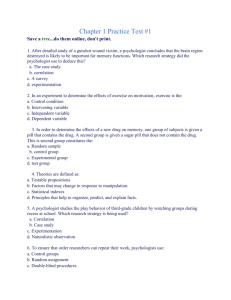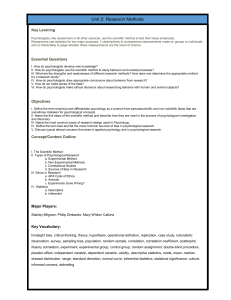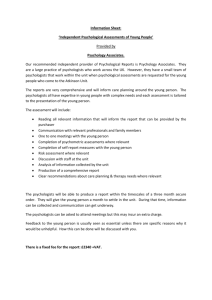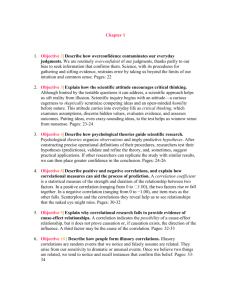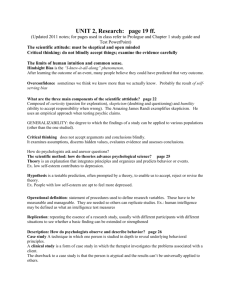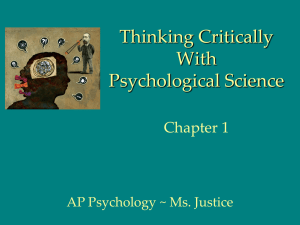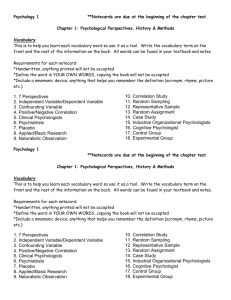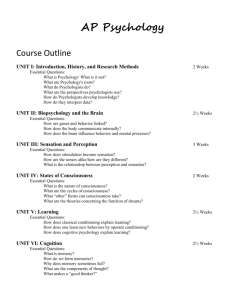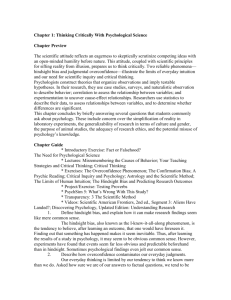History, Perspectives, Research Review Handout
advertisement
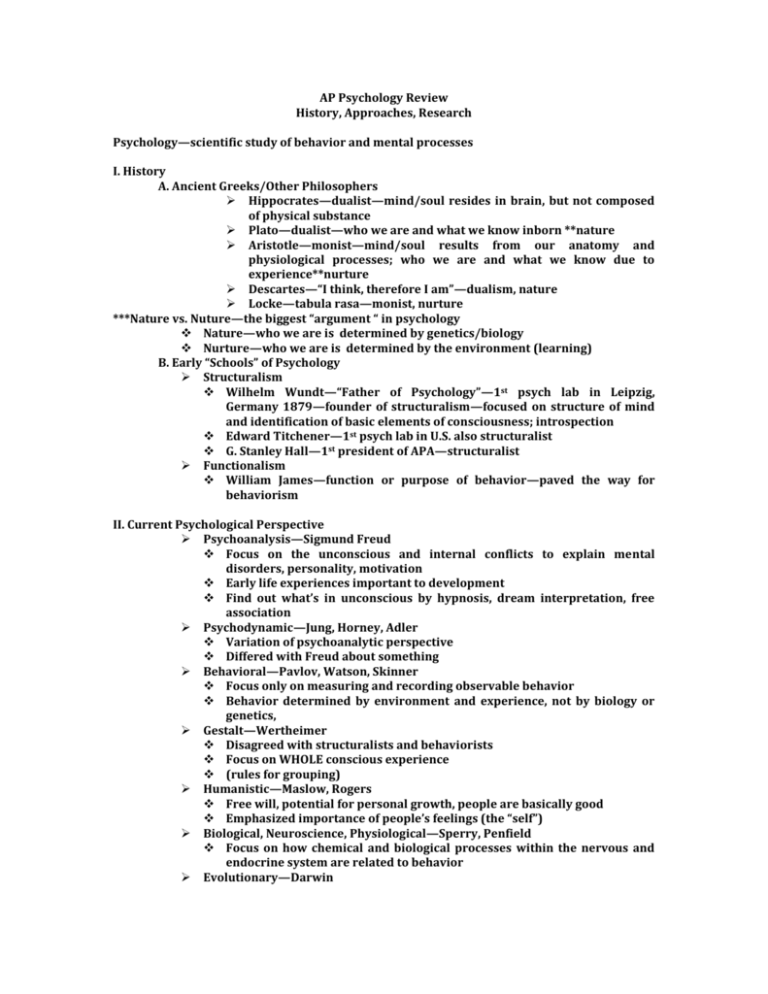
AP Psychology Review History, Approaches, Research Psychology—scientific study of behavior and mental processes I. History A. Ancient Greeks/Other Philosophers Hippocrates—dualist—mind/soul resides in brain, but not composed of physical substance Plato—dualist—who we are and what we know inborn **nature Aristotle—monist—mind/soul results from our anatomy and physiological processes; who we are and what we know due to experience**nurture Descartes—“I think, therefore I am”—dualism, nature Locke—tabula rasa—monist, nurture ***Nature vs. Nuture—the biggest “argument “ in psychology Nature—who we are is determined by genetics/biology Nurture—who we are is determined by the environment (learning) B. Early “Schools” of Psychology Structuralism Wilhelm Wundt—“Father of Psychology”—1st psych lab in Leipzig, Germany 1879—founder of structuralism—focused on structure of mind and identification of basic elements of consciousness; introspection Edward Titchener—1st psych lab in U.S. also structuralist G. Stanley Hall—1st president of APA—structuralist Functionalism William James—function or purpose of behavior—paved the way for behaviorism II. Current Psychological Perspective Psychoanalysis—Sigmund Freud Focus on the unconscious and internal conflicts to explain mental disorders, personality, motivation Early life experiences important to development Find out what’s in unconscious by hypnosis, dream interpretation, free association Psychodynamic—Jung, Horney, Adler Variation of psychoanalytic perspective Differed with Freud about something Behavioral—Pavlov, Watson, Skinner Focus only on measuring and recording observable behavior Behavior determined by environment and experience, not by biology or genetics, Gestalt—Wertheimer Disagreed with structuralists and behaviorists Focus on WHOLE conscious experience (rules for grouping) Humanistic—Maslow, Rogers Free will, potential for personal growth, people are basically good Emphasized importance of people’s feelings (the “self”) Biological, Neuroscience, Physiological—Sperry, Penfield Focus on how chemical and biological processes within the nervous and endocrine system are related to behavior Evolutionary—Darwin behavior a product of natural selection—we behave in ways that enhance our chances of reproductive success, survival of species Cognitive—Piaget, Ellis, Beck Importance of receiving, storing, processing information; of thinking and reasoning, and of language to understand behavior Sociocultural—Milgram, Zimbardo, Asch How social and environmental forces influence behavior These are all approaches that help to explain our behavior and mental processes. There is one “right” approach. III. Domains of Psychology—types of psychologists A. Clincial psychologists—evaluate and treat psych. Disorders B. Counseling psychologists—help people adapt to change or make changes in lifestyle C. Developmental psychologists—study how we develop psychologically during life D. Forensic psychologists—apply psychological principles to legal issues E. Idustrial/Organizational psychologists—apply psychological principles to making workplace more efficient F. Neuropsychologists—explore relationship between brain/nervous system and behavior G. Psychometricians—focus on psychological testing H. School psychologists—assess and counsel students I. Social psychologists—focus on how our behavior and mental processes are affected by others J. Sports psychologists—help athletes with their mental “focus” and performance IV. Research—what we know in psychology is known because of research . Psychologists aim to describe, understand, predict, and explain psychological phenomena. A. Scientific Method 1. formulate research question 2. develop hypothesis 3. collect data 4. analyze data B. Descriptive Research Studies—purpose is to describe behavior or mental processes Case studies—in-depth study of one person or group Used with rare phenomena Danger when generalizing to entire population when case study subject is not typical of population Freud Naturalistic Observation—observing animal or person in natural setting Subjects should not be aware of researcher’s presence—may affect behavior Jane Goodall, chimpanzees Survey—questionnaire Subjects should be chosen at random and be representative of population Be careful of volunteer bias, social desirability bias C. Correlational Research—purpose is to note relationships between variables Does NOT prove cause and effect….”correlation does not prove causation” Positive correlation—both variables move in same direction (up or down) Negative correlation—both variables move in opposite directions Strength of correlation represented by correlation coefficient Ranges from +1.0 to -1.0 (r = .78) The greater the number the stronger the correlation (positive or negative) Correlations can also be represented graphically (x, y axis)--scatterplot Positive correlation—upward sloping (grades, study time) Negative correlation—downward sloping (grades, party time) No correlation—no slope, points scattered (grades, eye color) D. Experimental Research—the only type of research that can establish cause and effect Researcher manipulates a variable under controlled conditions and observes response IV—Independent variable—variable being manipulated (new medication) DV—Dependent variable—variable affected by IV (depressive symptoms) If, then……”if subject takes new antidepressant medication (IV), then depressive symptoms should lessen”…. Random assignment—subjects placed in experimental group or control group at random Experimental group—gets the IV Control group—does not get IV Confounding variables—factors other than the IV that could affect the outcome of the experiment Single blind—participants don’t know which treatment group they’re in Double-blind—neither participants nor experimenter knows who is in which group; eliminates experimenter bias Placebo—fake pill, injection, treatment E. Statistics—how researchers make sense of data Descriptive Statistics—summarize set of data obtained from a sample Frequency distribution—an orderly arrangement of scores indicating the frequency of each score or group of scores Measures of central tendency—describe the average or most typical score in a set of scores o Mean—average score o Median—middle score (when scores arranged in order) o Mode—the most frequently occurring score Normal distribution—aka “bell-shaped curve”---most scores clustered around the middle of the distribution 68% of population—scores between +1 and -1 standard deviation from mean 95% of population—scores between +2 and -2 SD from mean 99.7% scores between +3 an -3 SD from mean Variability—the spread or dispersion of the scores Range—difference between highest and lowest score (highest score is 100, lowest is 20 = a range of 80) Standard deviation—the degree to which scores differ from each other (how clustered they are vs. how dispersed they are). The larger the SD, the more “spread out” or dispersed scores are. Inferential statistics—used to interpret data and draw conclusions Whether or not results can be generalized to population Statistical significance (p)—measure of likelihood that the difference between groups results from a real difference between groups rather from chance alone……p<.05 F. Ethical Guidelines—set forth by APA ---experiment must be approved by IRB in advance Informed consent/free to withdraw at any time No harm to participants Confidentiality Debriefing after research

